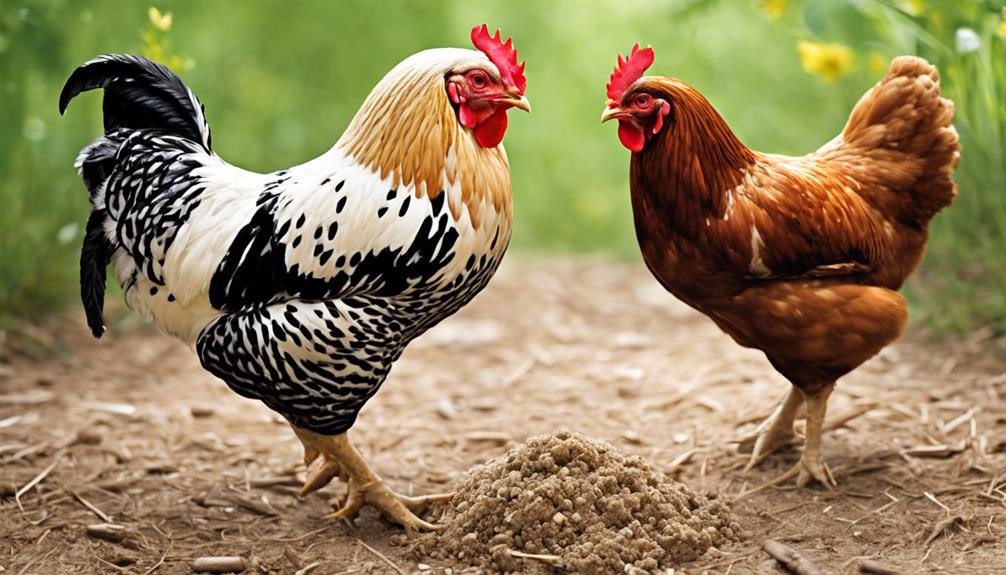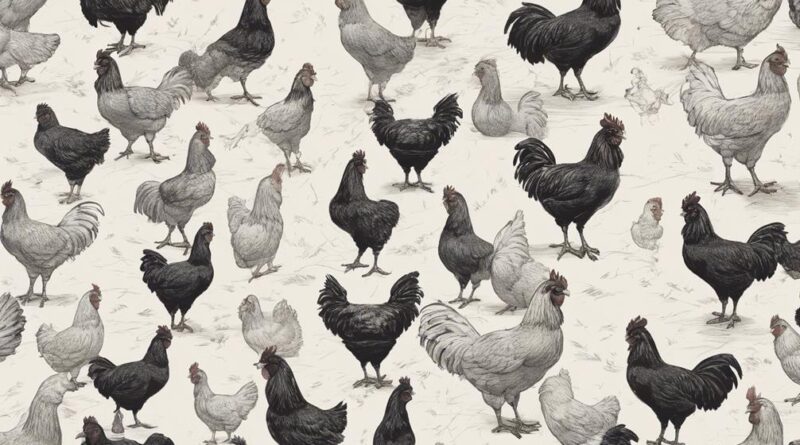Decoding Chicken Behavior: Top Methods Unveiled"
When it comes to deciphering the intricate world of chicken behavior, various methods have been unveiled to shed light on their communication and social interactions. By honing in on their body language, vocal patterns, and flock dynamics, a whole new realm of understanding opens up. These insights not only offer a glimpse into their daily routines and reproductive processes but also pave the way for enhancing their well-being and productivity. The key lies in unraveling these top methods to truly grasp the complexities of our feathered companions.
Body Language Interpretation
Understanding chicken body language is crucial for deciphering their communication signals effectively. When observing your chickens, pay close attention to their facial expressions and movement patterns. Chickens use a variety of facial expressions to convey their emotions and intentions. For example, a relaxed chicken will have its eyes half-closed, while wide-open eyes may indicate alertness or fear. Similarly, a chicken with its beak open and tongue flicking is likely experiencing distress or discomfort.
Movement patterns also play a significant role in understanding chicken body language. Chickens have specific ways of moving that can signal different messages. For instance, rapid movements accompanied by loud vocalizations often indicate agitation or aggression. On the other hand, slow and deliberate movements may suggest contentment or a lack of threat perception. Pay attention to how your chickens walk, run, or flap their wings, as these movements can provide valuable insights into their current state of mind.
Vocalization Analysis
When deciphering chicken behavior, examining their vocalizations can provide crucial insights into their communication signals and emotional states. Chickens have a diverse range of vocalization patterns that can convey various messages. By paying attention to these sounds, you can better understand what your chickens might be trying to communicate.
Vocalization patterns in chickens can include clucking, squawking, crowing, and even purring. Each of these sounds serves a different purpose, such as alerting others to danger, expressing contentment, or establishing dominance within the flock. By observing when and why these vocalizations occur, you can start to decipher the meaning behind them.
Moreover, vocalization analysis can be a helpful tool in behavior modification for chickens. For instance, if you notice that a particular sound is consistently associated with aggression or fear in your flock, you can work on addressing the underlying issues causing these negative emotions. By implementing changes in their environment or handling practices, you may be able to influence their vocalizations towards more positive expressions.
Flock Dynamics Observation
Observing the dynamics within your chicken flock reveals valuable insights into their social structure and interactions. Social interactions among chickens are fascinating to observe, as they engage in various behaviors that establish a dominance hierarchy within the flock. One key aspect to pay attention to is how chickens interact during feeding times, as this often reflects their social dynamics.
In a typical flock, you may notice certain chickens pecking others to establish their dominance. This behavior is a common way for chickens to assert their position within the hierarchy. The dominant chickens will often have priority access to food and resources, while subordinate chickens may wait their turn or seek out food in less crowded areas.
Beyond feeding times, observing how chickens interact during roosting or when exploring their environment can also provide insights into their social structure. Dominant chickens may take the highest perches or lead the flock in foraging activities, while subordinate chickens may follow behind or keep their distance.
Feeding and Foraging Behaviors
To gain further insights into the social hierarchy of your chicken flock, it's imperative to closely observe their feeding and foraging behaviors. Chickens have various foraging techniques that they employ to find food. Scratch foraging, where chickens use their feet to dig and scratch at the ground, is a common behavior. This technique allows them to uncover insects, seeds, and plants. Chickens also engage in pecking foraging, where they peck at the ground to pick up small seeds or insects. Observing these foraging techniques can give you valuable information about your chickens' natural instincts and preferences.
When it comes to feeding preferences, chickens can be picky eaters. They've individual likes and dislikes when it comes to food. Some chickens may prefer grains, while others might enjoy fruits and vegetables more. By monitoring what your chickens eat first and how they react to different foods, you can tailor their diet to ensure they're getting the right nutrients. Additionally, understanding their feeding preferences can help you introduce new foods or supplements to their diet more effectively.
Roosting and Nesting Habits
Understanding the roosting and nesting habits of your chicken flock is essential for ensuring their well-being and comfort in their living environment. Chickens have specific sleeping patterns and nesting preferences that are crucial to comprehend for proper care.
Roosting habits are ingrained in chickens' instincts. They prefer to perch on elevated areas at night, seeking safety from predators. Providing roosting bars in the coop encourages this behavior and helps prevent floor overcrowding. Observing your chickens' roosting habits can also indicate their health and social dynamics within the flock.
When it comes to nesting preferences, chickens show a strong inclination towards secluded, dark, and cozy spots for laying eggs. Providing nesting boxes filled with soft bedding material satisfies this instinct and encourages hens to lay eggs in designated areas, making egg collection easier for the flock owner. Understanding the egg laying routines of your chickens helps in managing their reproductive health and ensures a steady supply of fresh eggs.
Aggression and Pecking Order Study
An important aspect of chicken behavior that significantly impacts their social dynamics and well-being is the study of aggression and the establishment of a pecking order within the flock. Understanding aggression patterns and the dominance hierarchy in chickens can provide valuable insights into their social structures.
Aggression in chickens can manifest in various ways, such as pecking, chasing, or even physical fights. These aggressive behaviors are crucial for establishing a pecking order, which is a social hierarchy within the flock. The pecking order helps maintain order, reduce conflict, and allocate resources efficiently.
Observing aggression patterns can reveal how individual chickens establish and maintain their rank within the dominance hierarchy. Dominant chickens display more aggressive behaviors and often have priority access to food, water, and preferred roosting spots. Subordinate chickens, on the other hand, may exhibit submissive behaviors to avoid conflicts with higher-ranking individuals.
Researchers study aggression and the pecking order by observing chicken interactions, recording aggressive behaviors, and analyzing social dynamics within the flock. By understanding these aspects of chicken behavior, farmers and researchers can implement strategies to reduce stress, improve welfare, and enhance productivity in poultry farming operations. Ultimately, decoding the complexities of aggression and the pecking order in chickens contributes to better management practices and overall well-being of the flock.
Environmental Response Monitoring

Monitoring the environmental responses of chickens can offer valuable insights into how their behavior is influenced by external factors. Temperature sensitivity assessment plays a crucial role in understanding how chickens react to varying temperatures. By monitoring their responses to heat or cold stress, researchers can determine the optimal temperature range for these birds, ensuring their well-being and productivity. High temperatures, for example, can lead to decreased feed intake and egg production, while low temperatures may result in higher energy expenditure to maintain body warmth.
Social interaction monitoring is another essential aspect of environmental response monitoring. Chickens are highly social animals, and their interactions within a group can significantly impact their behavior. Observing their social dynamics, such as pecking order establishment and flock cohesion, provides valuable information on their stress levels, dominance hierarchies, and overall well-being. Disruptions in social interactions can lead to aggressive behavior, decreased egg production, and even health issues among the flock.
Reproductive Behavior Evaluation
Reproductive behavior in chickens plays a pivotal role in the overall health and productivity of the flock. Understanding the courtship rituals and mating displays of chickens is crucial for breeders and farmers alike. Courtship rituals in chickens often involve intricate behaviors aimed at attracting a mate. Roosters, for instance, may puff out their chest, extend their neck, and emit low clucking sounds to gain the attention of hens. Observing these courtship behaviors can provide valuable insights into the reproductive readiness of the flock.
Mating displays are another essential aspect of reproductive behavior evaluation in chickens. These displays can vary widely among different breeds but generally involve the male performing elaborate dances or vocalizations to entice a female to mate. The success of these mating displays can impact the overall breeding success and genetic diversity of the flock. By closely monitoring these displays, breeders can optimize breeding programs and ensure the health and vitality of future generations.
Frequently Asked Questions
How Do Chickens Perceive Time and Memory?
Chickens perceive time and memory differently than humans. Their time perception is influenced by daily routines like feeding times. Memory recall in chickens is essential for survival, helping them remember locations of food sources and potential dangers.
These cognitive abilities are crucial for their adaptation to the environment. Understanding how chickens perceive time and utilize memory can provide insights into their behavior and improve welfare practices.
Can Chickens Differentiate Between Colors and Patterns?
Chickens have impressive visual processing skills, enabling them to differentiate between colors and patterns. Their cognitive abilities allow for color recognition and pattern discrimination. These capabilities are crucial for survival in the wild and also play a role in social interactions within a flock.
Do Chickens Have a Sense of Self-Awareness?
Chickens don't typically show signs of self-awareness in self-recognition studies. When subjected to mirror tests, they usually don't interpret their reflections as themselves, indicating a lack of self-awareness.
This behavior contrasts with some highly intelligent animals that can recognize themselves in mirrors. Chickens' limited ability in this area suggests that they may not possess a strong sense of self-awareness compared to certain other species.
What Role Does Play Behavior Serve in Chicken Social Interactions?
In chicken social interactions, play behavior plays a crucial role in fostering social bonding and maintaining healthy flock dynamics. Through playful activities like chasing, pecking games, and dust bathing, chickens establish hierarchies, strengthen relationships, and reduce stress within the flock.
These interactions help chickens learn important social skills, communicate effectively, and establish a sense of cohesion and unity within the group. Play serves as a foundation for cooperative behavior and overall well-being in chicken communities.
How Do Chickens Communicate With Each Other Over Long Distances?
Chickens communicate over long distances through a variety of methods, including vocalizations and body language. Within a flock, they establish intricate dynamics that enable them to convey messages effectively.
Through clucks, cackles, and visual signals, chickens alert others to potential threats, food sources, or simply maintain social bonds. Understanding these communication strategies is key to comprehending flock dynamics and the overall behavior of chickens in their natural habitat.
Conclusion
In conclusion, by utilizing a multifaceted approach to decoding chicken behavior, researchers can gain valuable insights into their communication signals, social hierarchies, and overall well-being.
Understanding their body language, vocalizations, flock dynamics, feeding habits, aggression patterns, environmental responses, and reproductive behavior is crucial for improving welfare and optimizing breeding programs.
By studying these methods, we can ensure the health and vitality of chicken flocks for generations to come.
